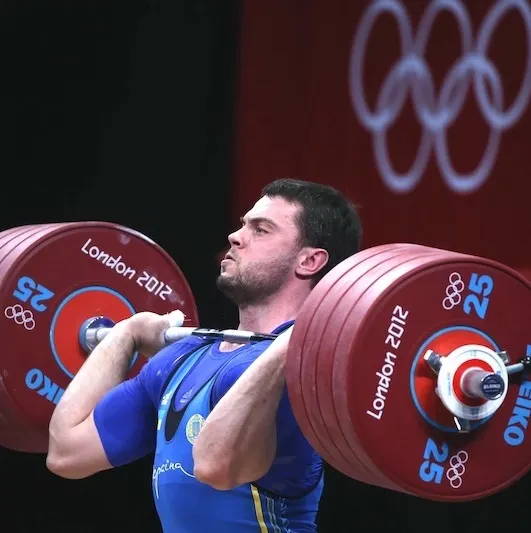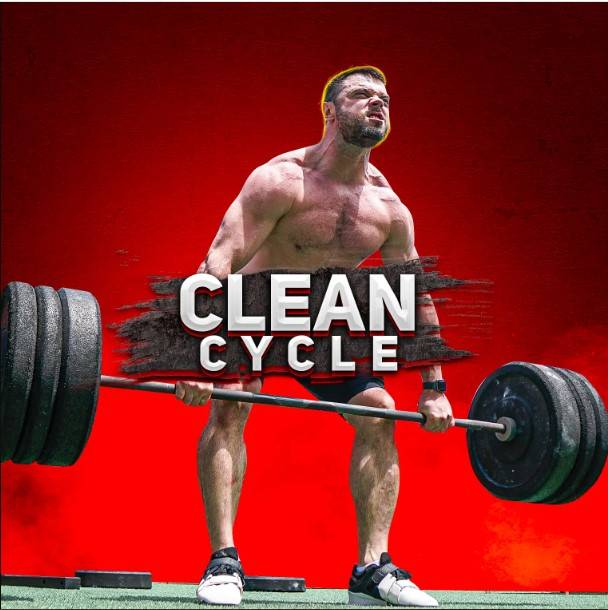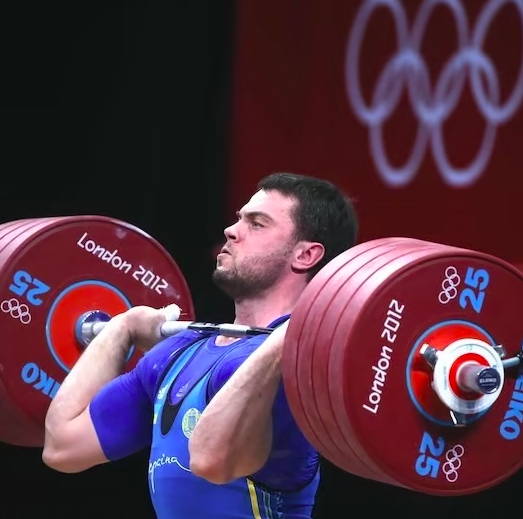January 17, 2025
Hang Power Clean: Technique, Benefits and Common Mistakes
If you want something dynamic and powerful to add to your routine, the hang power clean might just be what you need. This is an exercise that will boost your explosive power and engage a lot of major muscle groups, so you’ll get a well-rounded workout out of it.
You could be an athlete looking for ways to get a competitive edge, a weightlifter wanting to work on their technique, or a regular gym-going Joe, the hang power clean has something to offer for everyone.
Let’s dive right in and explore everything there is to know about this exercise – how to do it, what benefits you can expect to get, variations and alternatives to keep things fresh, some mistakes to avoid…. Basically, everything!

What Is the Hang Power Clean?
The hang power clean is a weightlifting exercise in which you lift a barbell from a “hang” position – either low (just above the knees) or high (mid-thigh) – to a “clean” position, where the bar rests on the front of your shoulders. Unlike a regular clean, which starts from the floor, the hang power clean starts from a hanging position above the ground.
This explosive movement is meant to develop power, strength, and speed. It’s focusing on your ability to generate force quickly. In the hang power clean, the bar is caught in a half squat instead of a deep squat, and it requires the bar to travel higher. This adjustment means that you typically can’t lift as much weight as with a full clean.
The hang power clean targets mostly your legs, back, shoulders, and core.
How to Do the Hang Power Clean?
1. Starting Position

2. Second Pull and Power Position

3. Turnover and Catch

4. Recovery
How to Program Clean and Press?
Beginner
- Do 3-5 sets of 3-5 reps per set to keep the accuracy.
- Do the hang power clean 2-3 times per week
- Use either an empty barbell or very, very light weights because your priority is learning the form. As you get more comfortable with the exercise and you learn the form, you can increase the weight by 5-10 lbs
Intermediate
- Do 3-5 sets of 3-4 reps per set
- Do the hang power clean 1-2 times a week
- Keep a close eye on your form. You can keep increasing the weight in 5-10 lbs increments but only if you’re able to do the exercise with correct form. Work on maximizing your power output; 65-80% of your 1RM may be ideal for that.
Advanced
- Do 3-5 sets of 1-3 reps per set
- Do the hang power clean with different weights to address what needs to be addressed – speed, power, strength, technique.
- Include that movement into your oly lifting complexes.
Follow us!

FREE

FREE
Get a 2-week Weightlifting Program as a bonus for the subscription to kickstart your training plan!
4 Common Hang Power Clean Mistakes
❌ Bar Too Far from the Body

❌ Lack of Confidence
❌ Low Elbow Position in the Catch

❌ Not Warming Up Properly
5 Benefits of Hang Power Clean
There are many hang power clean benefits. For example, studies have shown that it can improve your power, resulting in better performance in sports an activities that rely on high power outputs. Sounds impressive, right? Let’s see what else it can do for you.
✅ Improved Explosive Power
The hang power clean is dynamic and trains your muscles to quickly generate force. That explosiveness is really important for athletes in sports that need quick, powerful movements, like springint, jumping, and throwing.
✅ Increased Full-Body Strength
This is an exercise that engages a lot of major muscle groups, so when you include it into your routine, you can build overall strength and muscular coordination.
Tips From the Champ

Olympic Weightlifting Champion
✅ Improves Second Pull and Fast Turnover
The hang power clean focuses on the second pull and the turnover. When you start form a hang position, you can concentrate on generating maximum momentum power during the second pull and practice quick, efficient turnover and catch.
✅ Lower Entry Point
This exercise is excellent for people who can’t or just don’t want to do the traditional clean. Since you’re starting from a hang position, there’s no need for a deep squat, so it’s more accessible and you still get the benefits of a power clean.
✅ Improved Coordination
Your upper and lower body need to be in sync if you want to do the hang power clean correctly, so over time, it will help you develop better neuromuscular communication and body awareness in general.
Crush Your CLEAN PR in 5 Weeks! 🏋️
Achieve:
🏅New CLEAN Records.
💪Master CLEAN variations.
🏋️♂️Focus on back and leg strength.
🎯Specific skills and drills for your CLEAN.
Highlights:
📆 5 Days / Week
✅ Varied Lifts
💪 Strength & Technique
🔥 Healthy Warm-Ups
Elevate your CLEAN game today! 💥
2 Hang Power Clean Variations
We all love the hang power clean, but you need to switch it up sometimes to keep things interesting. If you’re really brave, you can do it standing on one leg because that will develop your explosive power and force input even more, but if you don’t want to risk it, here are some variations.
1. High Hang Power Clean
For this variation, you’ll hold the bar just above your knee and this will be your starting point. This exercise helps improve speed and power in the second pull and it’s great for athletes (or anyone else) who want to work on their quick, explosive movements.
2. Low Hang Power Clean
Here, you’ll start off with the bar being just below your knees. This variation needs a deeper bend, so it promotes greater stability and strength in the pull. It’s a great choice for people who want to improve their pulling power and improve a bit strength of their back.
3 Hang Power Clean Alternatives
You can never have too many exercises at your disposal, so when you get fed up with variations, mix it up with alternatives!
1. Power Clean
The power clean starts from the floor instead of the hang position and it gives you a greater range of motion that works more muscles. It’s a great alternative for people who want to improve their technique in the traditionalOlympic lifts.
2. Single or Double Kettlebell Clean
You lift one or two kettlebells from a hang position to your shoulders in a smooth, explosive motion. This exercise will improve grip strength, coordination, and explosive power.
3. Muscle Clean
The muscle clean is similar to the power clean, but there’s no squat catch. Lift the bar from the floor and pull it up to your shoulders without dropping into a squat. This exercise focuses on upper body strength and power and it’s a simpler than the hang power clean.
Who Should Do the Hang Power Clean?
Well, you’ve seen the benefits, so can you really think of anyone that the hang power clean wouldn’t be good for?
Of course, there are some specific groups of people that will particularly benefit from it, so let’s mention them.
1. Athletes
Athletes from a lot of sports can benefit from the hang power clean. It’s an exercise that improves power, speed, and athletic performance in general, all of which is important for activities like sprinting, jumping, and changing directions quickly. It has a lower entry point than regular clean because you don’t need to catch the bar in a full depth squat.
2. Weightlifters
Weightlifters and people who are training for Olympic competitions should have the barbell hang power clean as part of their routine. It’s excellent for improving clean technique, building power, and refining movements needed for other Olympic lifts.
3. Fitness Enthusiasts
If you’re a fitness junkie looking to improve your strength and conditioning, you should do the hang power clean. It will give you a full-body workout, improve muscle strength,. It can be a great addition to your WODs.
Muscles Worked by the Hang Power Clean
The hang power clean workout targets a lot of different muscle groups, so it’s a powerful full-body exercise.
It mostly works the lower body muscles, including the quads, hamstrings, glutes, and calves, which are important if you want to be able to generate explosive power. The upper body muscles, such as lower back, the traps, delts, and lats, are engaged as well.
Also, the biceps and forearms are involved in gripping and controlling the bar. The core, which includes the abs and obliques, helps maintain stability and balance throughout the lift.
Conclusion
What’s not to like about the hang power clean, right? It works many muscle groups, boosts your explosive power, improves coordination, helps keep your bones healthy and strong… There’s absolutely no reason why it shouldn’t be a part of your routine.
Have you tried it? If you have, what results have you noticed? If you haven’t, do you prefer some of the alternatives perhaps? Any tips or tricks for those that are new to this?
Leave your comments below!
References:
- Hyoung-Kil Park, Min-Kyung Jung, Eunkyung Park, Chang-Young Lee, Yong-Seok Jee, Denny Eun, Jun-Youl Cha, and Jaehyun Yoo. “The effect of warm-ups with stretching on the isokinetic moments of collegiate men.” Journal of Exercise Rehabilitation 14, no. 1 (2018): 78–82.
- Naruhiro Hori, Robert Usher Newton, Warren A. Andrews, Naoki Kawamori, “Does Performance of Hang Power Clean Differentiate Performance of Jumping, Sprinting, and Changing of Direction?” Journal of Strength and Conditioning Research 22, no. 2 (2008): 412-418.
- Seiichiro Takei, Kuniaki Hirayama, Junichi Okada, “Is the Optimal Load for Maximal Power Output During Hang Power Cleans Submaximal?” International Journal of Sports Physiology and Performance 15, no. 1 (2023): 18-24.
- Stephan Geisler, Tim Havers, Eduard Isenmann, Jonas Schulze, Leonie K. Lourens, Jannik Nowak, Steffen Held, G. Gregory Haff, “Effects of Expertise on Muscle Activity during the Hang Power Clean and Hang Power Snatch Compared to Snatch and Clean Pulls – An Explorative Analysis,” Journal of Sports Science and Medicine 22, no. 3 (2023): 778-789.
- Ryohei Hayashi, Takuya Yoshida, Yasushi Kariyama, “Differences in Kinetics during One- and Two-Leg Hang Power Clean,” Sports 9, no. 4 (2021): 45.
- Photos by Torokhtiy Media Team.
Why Trust Us?
The product testing process is described in more detail here.
Experience: 21 years
Best Results: Snatch – 200 kg,
C&J - 240 kg
My name is Oleksiy Torokhtiy. I am a professional athlete with 20 years of experience in Olympic weightlifting. I have won multiple European, and World titles and have taken part in two Olympic Games (Beijing 2008, London 2012).
After finishing my career, I have committed myself to coach, and as of 2022, I’ve hosted 200+ weightlifting seminars all over the globe. I’m the founder of an international sportswear and accessories brand, Warm Body Cold Mind (my motto), author, and creator of a series of training programs and eBooks.
If you have any questions/suggestions/any other inquiry, you can reach out to us via email - reviews@torokhtiy.com




